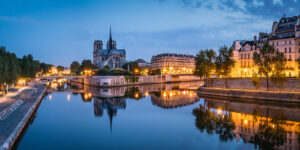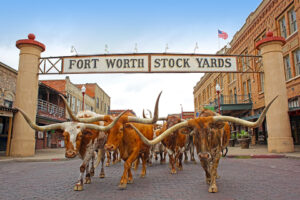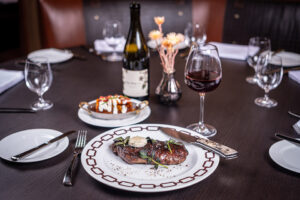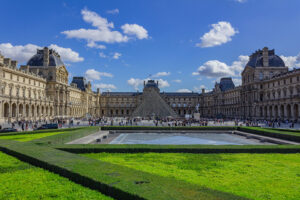
Paris and Fort Worth are kindred spirits of a sort with their illustrious art museums, railroad history and perfectly cooked steak dinners.
Fort Worth and Paris have more in common than you think
By Shilo Urban
One city began life as a rough-and-tumble fort in tribal lands, stoked its legend with rugged men on horseback and launched an enduring love affair with beef — and so did the other. As Paris prepares to host the 2024 Summer Olympics this July and August, the similarities between the French capital and Fort Worth might not be obvious. But the two cities are kindred spirits of a sort with their illustrious art museums, railroad history and perfectly cooked steak dinners … and they both evoke undying ardor in their fans.
A military outpost in tribal territory

Île de la Cité, the island in the middle of the Seine where Notre-Dame Cathedral now stands, was once a military fort built around 250 B.C.E. by the Parisii.
Iron Age France was a world of Celtic tribes, fierce warriors that had migrated westward across the European continent. Like the first Fort Worthians who settled on the Trinity River, a Celtic group called the Parisii made their home on the fertile banks of the River Seine. While not the earliest people to inhabit the area, the Parisii were the first to put down roots and establish an ongoing community.
Around 250 B.C.E., they constructed a military fort on the Île de la Cité, the island in the middle of the Seine where Notre-Dame Cathedral now stands. The Parisii minted coins, planted crops and erected a thick wall for protection in the lawless, Wild West-style landscape. We know all this from the writings of Julius Caesar, who showed up in 52 B.C.E. to claim the city for the Roman Empire, naming it Lutetia (Lutèce in French). A century later, his countrymen built a gladiatorial amphitheater that you can still visit today on the Left Bank: Les Arènes de Lutèce.
Valiant men on horseback
Brave, bold and determined, the cowboy’s abiding appeal spans the globe — and no city is more associated with this American icon than Fort Worth. Riding horses to faraway lands, cowboys espoused a code of honor: revere God, respect ladies and defend the weak.

The Stockyards and the cowboys who shaped the area have become an iconic part of Fort Worth.
Photo courtesy of Visit Fort Worth
But before the cowboy came the knight, another hero on horseback who shared the same stouthearted values. Being a chivalrous warrior was nonnegotiable if you wanted to be king of France, who for much of history ruled only the small realm encircling Paris. One monarch (Henry II) was even killed while proving his knightly mettle during a joust at the Place des Vosges.
More than any other medieval nation, France was famous for using armored chevaliers (horsemen) on the battlefield. French poets popularized the stories of King Arthur and his Knights of the Roundtable and invented the quintessential quest: the search for the Holy Grail. Fort Worth cowboys and Parisian chevaliers might hail from different centuries and continents, but they both embody the idea of freedom — and their potent mythologies continue to play integral roles in each city’s imagination.
The railroad changes everything
In 1876, the Texas & Pacific Railway pulled into Fort Worth and put the city on the map. Paris was already on the map in 1837 when its chemins de fer (paths of iron) arrived, but for both cities the appearance of the railroad delivered a dazzling influx of novel goods, new people and monumental train stations.
France’s national rail system debuted with six lines radiating outward from Paris in every direction, a design very similar to Fort Worth’s famous “tarantula” railroad map. The soaring train stations built across Paris during this era are still in use today, like the Gare du Nord and Gare Saint-Lazare — as is the 1928 T&P Station in Fort Worth.
But while Cowtown’s railways carried cattle and beef out of the city, Parisian trains brought foodstuffs in: creamy Camembert cheese from Normandy, ripe cherries from Provence and especially fresh oysters from the coast. A special rail line called the train des mouettes (seagull train) opened to transport oysters and nothing else in 1876, the very year that locomotives first rolled into Fort Worth.
Boeuf: It’s what’s for dinner

Steak from Fort Worth’s Bowie House
Photo by Olaf Growald
Savoring a plate of steak frites in a cozy bistro is a classic experience in the City of Light, especially if you order it cooked saignant (bloody) or even bleu (grilled one minute on each side). But for Parisians, beef is more than a delicious dinner — it’s the centerpiece of traditional cuisine, a proud cultural emblem that’s intertwined with the French identity itself.
Sound familiar? Beef has shaped France’s gastronomic character for centuries and appears in many of the most popular dishes, including beef bourguignon, steak tartare and pot au feu (beef stew).
The country’s rich agricultural heritage has made it a major beef producer for the European market, and French cattle breeds like the white Charolais and the brown Limousin can be seen strutting their stuff at the Fort Worth Stock Show each year. When it comes to cooking beef, mastery of heat and timing is the cornerstone of French culinary techniques — just as it is for smoked brisket. Cowtown’s barbecue pitmasters and five-star French chefs share this creative expertise, whether they know it or not.
Renowned art museums

The Louvre in Paris
Paris’ celebrated museums showcase the finest French artists from Cézanne and Gauguin to Matisse, Maillol and Monet. You’ll also find their works in the exceptional European collection at the Kimbell Art Museum, along with paintings by Gauguin, Degas and Manet — a veritable Who’s Who of French painters and sculptors. The Kimbell’s Piano Pavilion shares its Italian architect Renzo Piano with Paris’ Centre Pompidou, a marvelous “inside-out” building that houses Europe’s largest modern art museum.
While Fort Worth’s art museums — including the Modern and the Amon Carter — may not see quite as much traffic as the Louvre or the Musée d’Orsay, they are celebrated institutions in their own right that firmly establish Fort Worth’s presence on the international artistic stage.
Can’t make it to Paris for the Summer Olympics? You can indulge in authentic French flavors right here in Fort Worth with the tarte flambé at Le Margot, foie gras at Paris 7th or filet au poivre at Saint-Emilion.
